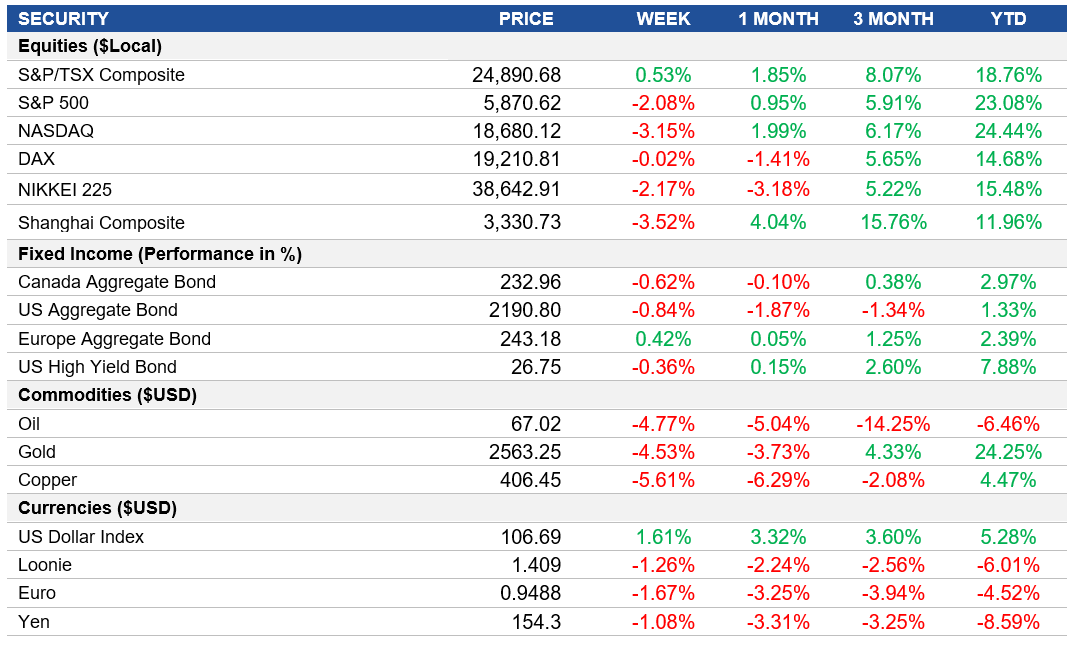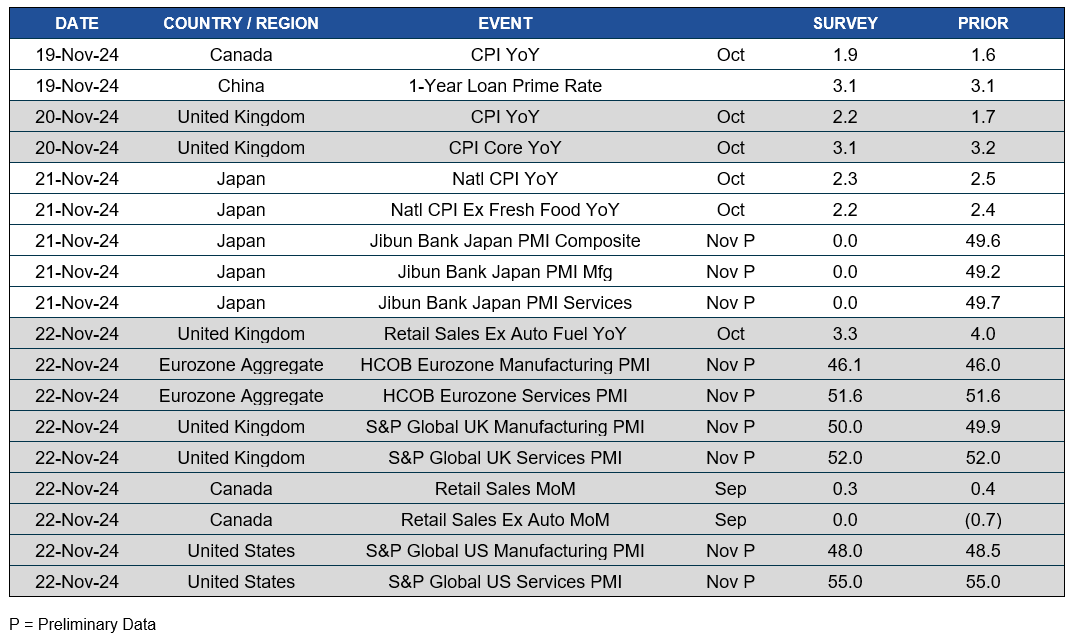Weekly Market Pulse - Week ending November 15, 2024
Market developments
Equities: The S&P 500 has retraced about one-third of its gains made post-election as optimism around corporate growth under Trump diminishes. Investors are now more cautious about potential budget deficits and inflationary pressures linked to Trump's policies. Vaccine stocks faced pressure due to concerns over health policy direction under Trump's administration. The broader market sentiment reflected unease about economic conditions and cabinet appointments affecting investor confidence.
Fixed Income: Powell's remarks highlighted ongoing economic growth and persistent inflation above the Fed's 2% target, leading to increased Treasury yields and reduced expectations for a December rate cut, now estimated at less than 60% probability compared to 80% the previous week.
Commodities: Gold prices have recently declined to near a two-month low, primarily due to shifting expectations regarding Federal Reserve interest rate cuts. Following comments from Fed Chair Jerome Powell, who emphasized the resilience of the U.S. economy, traders have reduced their forecasts for a rate cut in December. This has led to an increase in U.S. bond yields, which typically negatively impacts gold prices.
Performance (price return)

Source: Bloomberg, as of November 15, 2024
Macro developments
Canada – No Notable Releases
No notable releases this week.
U.S. – Inflation Rises, Factory Prices in the U.S. Climb, Headline Retail Sales Beat Expectations
The annual inflation rate increased to 2.6% in October, ending a seven-month decline, mainly due to smaller decreases in energy costs and steady shelter inflation. Food and transportation inflation slowed, while vehicle prices continued to drop. Monthly inflation held at 0.2%, driven by a 0.4% rise in shelter prices. Core inflation remained stable at 3.3%.
Producer prices rose 0.2% month-over-month in October, with annual PPI accelerating to 2.4%. Service costs increased, notably in portfolio management, while goods prices rose due to higher costs of carbon steel scrap and other commodities. Core PPI grew by 3.1% annually, slightly exceeding forecasts.
Retail sales grew by 0.4% in October, surpassing forecasts. Electronics, auto dealers, and food services saw the highest gains, while declines occurred in miscellaneous stores, furniture, and sporting goods. The growth followed an upwardly revised 0.8% increase in September.
International – U.K. Unemployment Rises, U.K. GDP Slows, Eurozone GDP Sees Strong Growth, Japan’s Producer Prices Rise, Japan’s Fragile Economic Growth, China’s Retail Sales Accelerate
The U.K. unemployment rate rose to 4.3% from July to September 2024, its highest since May, driven by a rise in short-term unemployment. Employment increased due to growth in full-time jobs, while the economic inactivity rate remained stable at 21.8%.
The U.K.'s GDP grew by 0.1% in Q3 2024, the slowest in three quarters, with gains in services, construction, and household spending offset by declines in production and capital formation. Year-on-year, GDP growth reached 1%, up from 0.7% in Q2.
Eurozone GDP expanded by 0.4% in Q3 2024, the fastest in two years, driven by rebounds in Germany, Ireland, and Austria. Growth accelerated in France, Spain, and smaller economies, while Italy stagnated, and Latvia remained in contraction. Annual GDP growth reached 0.9%.
Japan's producer prices grew by 3.4% year-on-year in October 2024, marking the highest increase since August 2023. Rising costs for commodities like petroleum, metals, and machinery drove the increase, while chemical product prices declined. Monthly PPI rose 0.2%, beating expectations.
Japan’s GDP grew 0.2% in Q3 2024, slowing from 0.5% in Q2, amid weak exports and declining business investment. Private consumption and government spending supported growth, reflecting rising wages and disaster relief efforts.
China’s retail sales surged by 4.8% year-on-year in October 2024, driven by a holiday, shopping events, and government support measures. Personal care, sports, and household appliance sales soared, while declines in jewelry and building materials slowed. Sales grew 3.5% in the first ten months of the year.
Quick look ahead

As of November 15, 2024
